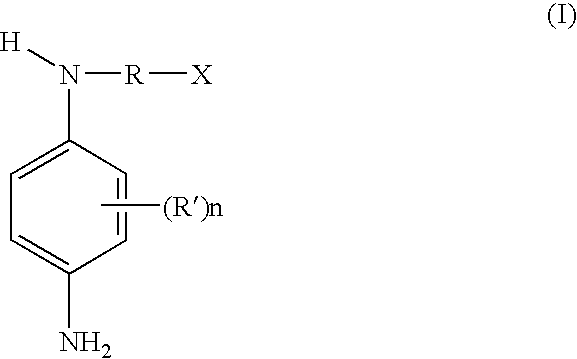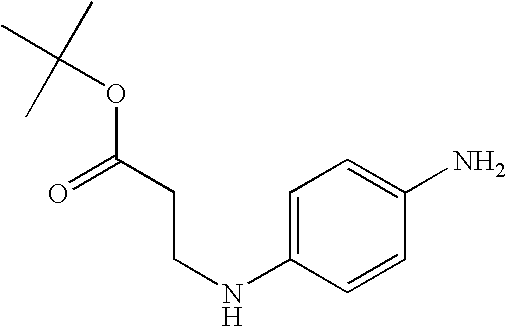Secondary para-phenylenediamines having a carboxyl group, dye compositions comprising the same, and dyeing processes using the compositions
a technology of paraphenylenediamine and carboxyl group, which is applied in the field of secondary paraphenylenediamine, and the use of dyeing processes using the compositions, to avoid the degradation of these fibers
- Summary
- Abstract
- Description
- Claims
- Application Information
AI Technical Summary
Benefits of technology
Problems solved by technology
Method used
Image
Examples
example 1
Synthesis of 3-[4-amino-2-(2-hydroxyethoxy)phenylamino]propionic acid, dihydrochloride (5)
[0165]
Step 1: Preparation of 3-(2-hydroxy-4-nitrophenylamino)propionamide (2)
[0166]15 g (0.1 mol) of 2-amino-5-nitrophenol, 7.8 g (0.11 mol) of acrylamide, 3 drops of 96% sulfuric acid and 20 mg of hydroquinone were maintained at 100° C. for 45 minutes. The mixture dissolved and an insoluble material was then formed, which was filtered off. This precipitate was taken up in 100 ml of refluxing toluene; after filtering while hot, 18 g of powder were obtained after re-slurrying in hot ethyl acetate (m.p.=194° C.).
[0167]
theoryfoundC48.0047.73H4.925.03N18.6618.57
Step 2: Preparation of 3-[2-(2-hydroxyethoxy)-4-nitrophenylamino]propionamide
[0168]2 g (8.8 mmol) of 3-(2-hydroxy-4-nitrophenylamino)propionamide obtained above dissolved in 10 ml of dimethylformamide and 7 ml of 15% alcoholic potassium hydroxide (0.015 mol) were brought to 95° C. 14 ml (0.2 mol) of 2-bromoethanol were added to this mixture ...
example 2
Synthesis of ethyl 3-(4-aminophenylamino)propionate dihydrochloride (7)
[0175]
Step 1: Synthesis of ethyl 3-(4-nitrophenylamino)propionate (6)
[0176]459 mg of 4-fluoronitrobenzene, 500 mg of β-alanine ethyl ester and 1.15 ml of Et3N were added to a solution of 10 ml of N-methylpyrrolidinone (NMP). The reaction medium was heated at 70° C. for 8 hours and, after cooling to room temperature, was then poured into a water and ice mixture. The yellow precipitate formed was filtered off, re-slurried in water and then dried over P2O5. 520 mg of ethyl 3-(4-nitrophenylamino)propionate (6) were obtained.
Step 2: Synthesis of ethyl 3-(4-aminophenylamino)propionate dihydrochloride (7)
[0177]The product obtained during the preceding step was reduced with a boiling zinc / ammonium chloride / water / ethanol mixture. The corresponding amine was isolated in dihydrochloride form.
[0178]The proton NMR and mass spectra were in accordance with the expected structure of the product.
[0179]Colored locks of hair were o...
example 3
Synthesis of ethyl 2-(4-aminophenylamino)-3-methylbutyrate dihydrochloride (9)
[0180]
Step 1: Synthesis of ethyl 2-(4-nitrophenylamino)-3-methylbutyrate (8)
[0181]162 mg of 4-fluoronitrobenzene, 200 mg of L-valine ethyl ester and 0.4 ml of Et3N were added to a solution of 10 ml of N-methylpyrrolidinone (NMP). The reaction medium was heated at 70° C. for 8 hours and, after cooling to room temperature, then poured into a water and ice mixture. The yellow precipitate formed was filtered off, re-slurried in water and then dried over P2O5. 100 mg of ethyl 2-(4-nitrophenylamino)-3-methylbutyrate (8) were obtained.
Step 2: Synthesis of ethyl 2-(4-aminophenylamino)-3-methylbutyrate dihydrochloride (9)
[0182]The compound obtained during the preceding step was reduced with a boiling zinc / ammonium chloride / water / ethanol mixture. The corresponding amine was isolated in dihydrochloride form.
[0183]The proton NMR and mass spectra were in accordance with the expected structure of the product.
[0184]Color...
PUM
| Property | Measurement | Unit |
|---|---|---|
| Fraction | aaaaa | aaaaa |
| Fraction | aaaaa | aaaaa |
| Fraction | aaaaa | aaaaa |
Abstract
Description
Claims
Application Information
 Login to View More
Login to View More - Generate Ideas
- Intellectual Property
- Life Sciences
- Materials
- Tech Scout
- Unparalleled Data Quality
- Higher Quality Content
- 60% Fewer Hallucinations
Browse by: Latest US Patents, China's latest patents, Technical Efficacy Thesaurus, Application Domain, Technology Topic, Popular Technical Reports.
© 2025 PatSnap. All rights reserved.Legal|Privacy policy|Modern Slavery Act Transparency Statement|Sitemap|About US| Contact US: help@patsnap.com



